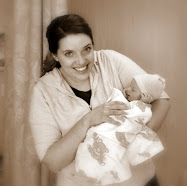LWA-Stephen Welstead / Corbis
The rise in cesarean-section deliveries in recent years has been characterized by some as a key indication of the overmedicalization of childbirth. While the procedure undoubtedly saves lives and leads to better health outcomes for mothers and infants who face problems during pregnancy and labor, many experts say the procedure is being performed too often, and in many cases for nonmedical reasons, putting healthy women and babies at undue risk of complications of major surgery.
The rate of C-sections has reached more than 31% in the U.S., a historical high, according to 2007 data from the American College of Obstetricians and Gynecologists (ACOG). The reasons for the increase are many and have been widely discussed: the rising rate of multiple births, more obesity in pregnant women, the older age of women giving birth. In fact, C-sections have become so common that many women may have an inflated sense of safety about them. "For the most part, moms and babies go through the process healthy and come out healthy, so maybe there's this sense that we're invincible," says Dr. Caroline Signore of the Eunice Kennedy Shriver National Institute for Child Health and Human Development.(See pictures of pregnant-belly art.)
But C-section carries all the attendant risks of major surgery; and data show that compared with vaginal birth, cesarean delivery increases the odds that a mother will end up back in the hospital after birth with complications such as bleeding or blood clots.
Now obstetrics experts are actively seeking ways to drive down the number of C-sections. On July 21, the ACOG issued new guidelines recommending that hospitals allow most mothers who desire vaginal birth after cesarean, or VBAC, to attempt a trial of labor, including some mothers who are carrying twins or have had two prior C-sections. Despite studies showing VBAC to be safe for most women — ACOG data suggests that 60% to 80% of women who attempt VBAC will succeed — many hospitals have urged women to undergo a repeat cesarean over the past decade, largely to avoid medical risks and malpractice suits.(Read how postpartum depression can strike fathers.)
Another factor contributing to high C-section rates is the increase in induced labor, especially between 37 weeks and 38 weeks of gestation — a period obstetricians describe as "early term." (While any birth between 37 weeks and 41 weeks is considered full term, some experts distinguish the earlier period.) The use of labor induction in the U.S. has risen from less than 10% of deliveries to more than 22%, between 1990 and 2006, according to data from the Centers for Disease Control and Prevention, and research suggests that induced labor results in C-sections more often than natural labor. A study published in the July issue of the journal Obstetrics & Gynecology found that among more than 7,800 women giving birth for the first time, those whose labor was induced were twice as likely to have a C-section delivery as those who experienced spontaneous labor.
The study's lead author, Dr. Deborah Ehrenthal of Christiana Care Health System in Newark, Del., says that she was not surprised to see an association between induction and risk of C-section, since previous studies had come to the same conclusion. But Ehrenthal says she was surprised by the high rate of induction overall. In her study of ethnically and socioeconomically diverse mothers delivering before 41 weeks' gestation, who did not have pregnancies complicated by breech presentation, 44% of women had their labor induced.(Read about the risks of late preterm births.)
The rate is significant because ACOG guidelines, which have been in place since 1982, recommend against elective inductions in the early term, or anytime before 39 weeks. Research shows that after 41 weeks' gestation, at which point it is standard policy to induce labor, it may lower the risk of medical complications for mother and baby — including the risk of stillbirth — and even decrease the likelihood of C-section delivery, but those same effects are not seen in women who induce labor before the 41-week mark.
Medical reasons for earlier induction may include advanced size or lack of proper growth of the fetus and maternal issues like diabetes. But in an editorial accompanying Ehrenthal's paper, Signore also suggests that the high rate of early-term induction may reflect lifestyle choices: health care providers' and new parents' desire to control the timing of delivery. "Many women believe that delivering a few weeks early is just as safe as delivering on the projected due date and may request delivery for any number of reasons of comfort or convenience," Signore writes. "However, we must remember that incautious use and timing of interventions — particularly in elective cases — can lead to unnecessarily poorer outcomes for women and newborns."
Among the women whose labor was induced in Ehrenthal's study, nearly 40% of cases were categorized as elective. In other words, there was no pressing medical indication for induction. Extrapolating from the study findings, Ehrenthal suggests reducing the use of elective labor induction could lower the national C-section rate by as much as 20%.
Several hospitals have already begun reducing medically unnecessary induction as a way to lower the rate of cesareans. In 2006, the Magee-Womens Hospital in western Pennsylvania began limiting the pool of women eligible for elective inductions to those delivering after 39 weeks. The hospital also established stricter protocols for elective induction in women after 39 weeks — insisting on high levels of cervical "ripeness" as measured by the standard Bishop score before induction — and prohibited other labor-hastening efforts, such as the use of cervical ripening agents. Additionally, the hospital instituted a new scheduling system requiring physicians to document specific reasons for induction when used.
Researchers found that under the new policy the overall induction rate dropped 33% and the rate of elective inductions fell by roughly the same amount. What's more, the total number of C-sections among first-time mothers who underwent elective induction dropped 60%. The results of the Magee-Womens study were published in April 2009 in the journal Obstetrics & Gynecology.
If a relatively simple policy shift based on medical evidence can successfully cut the rate of induced labor and C-sections at a single hospital, experts say similar changes applied broadly may help lower the rate of C-sections on a national level.
But as with the new guidelines regarding VBACs, decisions about labor induction and other issues surrounding childbirth must be shared by women. Patients should be informed and included in the decisionmaking process, Ehrenthal says. "Unlike the decision to do an emergency C-section where there's no time to talk, usually there is time to have a discussion about induction," she says.
Read more: http://www.time.com/time/health/article/0,8599,2007754,00.html#ixzz1PApJAvQV



No comments:
Post a Comment